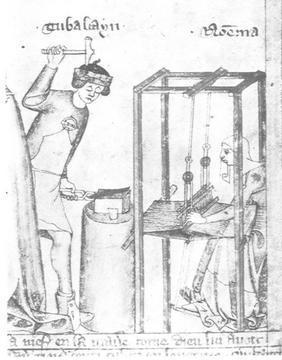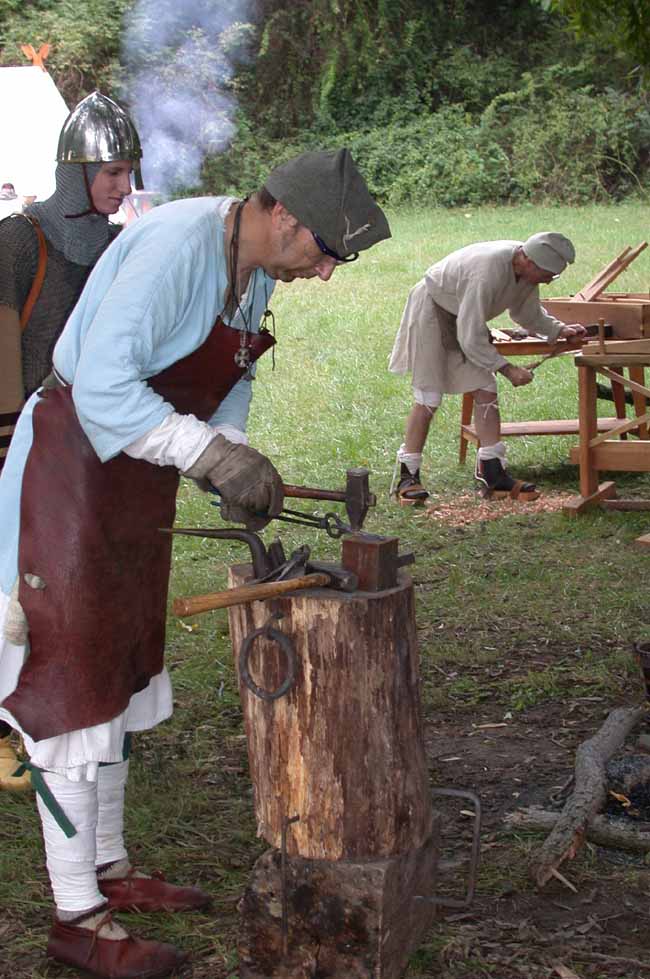A request for more historic information, and separately a private comment that answered that question.
Cathy Raymond left a new comment on the post "Protective Aprons :
Here's a slightly different question. Did smiths wear protective
aprons in the Viking age and, if so, what were they like? Do we have
any information that would help answer that question?
The historic source comes from *Bruce Blackistone*, a well known and respected Early Medieval / Anglo Saxon period re-enactor, fellow blacksmith, and one of the forces behind the Longship Company (and old friend). I have come to have a lot of respect for Bruce's depth of research, general understanding of history and technology - and especially his warped (often perceptive) sense of humour.

Some more grist for your mill: Attached is an English
illustration of Tubal Cayne, circa 1360.
I wear a modified version of the apron, which just happens to work
out to the steer's neck and shoulders for the bib, and the back
forms most of the rest of the skirt. In addition to the brooch
(which doesn't work that well with modern attire) I use a neck
strap. A second tie runs from the start of the legs to my back
and around the waist to cinch it in.
As shown, it has proven practical in a number of centuries. IBruce also commented :
only wish I had spent just a little more to make it a few inches
longer, but the length has never actually proved a problem.
First picture is from the British Museum. Second photo was by
*Katy Amt*.
I will also observe that the limiting of damage to clothing was one of the reasons that I wished my leather apron a little longer. Nothing like hot "fire flea" coals burning through the lower hem of your nice, new linen undertunic. I couple of scorches and holes adds veracity, but after a short while, too much can be way too much. Not to mention the possibility of ignition!
A general observation back to the question:
I am not aware there is are any actual artifacts themselves that survive from the Viking Age that would be considered metalworkers aprons. There are three carvings I am aware of that illustrate blacksmiths :
the Hyllestad Wood Carving - http://www.warehamforge.ca/BLOG/smithcarve.jpg
the Ramsund Rune Stone - http://www.warehamforge.ca/ironsmelting/images/rockillo.jpg
the Frank's Casket - http://wps.pearsoned.co.uk/wps/media/objects/14183/14524101/The%20Arch%20of%20Constantine%20Rome/image022.jpg
None of these Viking Age illustrations show the smith wearing a specific apron.
There are two reasons however, that I would consider the wearing of an apron most likely for the early blacksmith:
1) Safety
2) Limit damage to clothing
That second is not often considered, especially from our modern bias of cheap, plentiful, easily accessible, *purchased* clothing. Clothing was limited, and 'expensive' to any European before the advent of the Industrial Age. The raw labour involved in the production of sheep to shirt is usually not taken into account. Admittedly, wool is much more resistant to the damage effects from small pieces of hot scale flaking off under the blacksmith's hammer. Still, in a world where getting a new shirt might be at best a one per year occurrence, individuals would be sure to protect their clothing, as much as themselves.





















1 comment:
Thank you, Darrell and Bruce, for the useful information!
Post a Comment